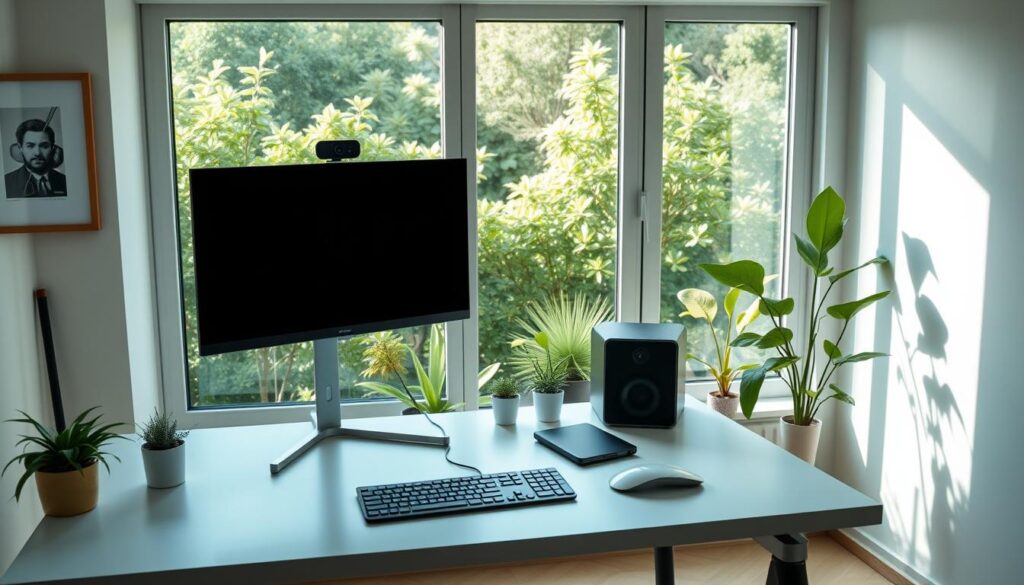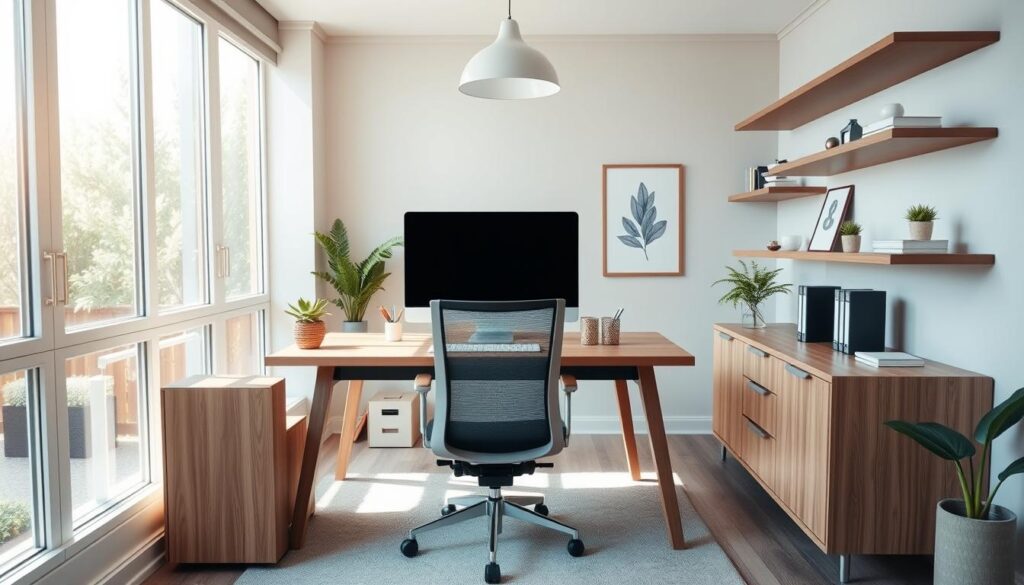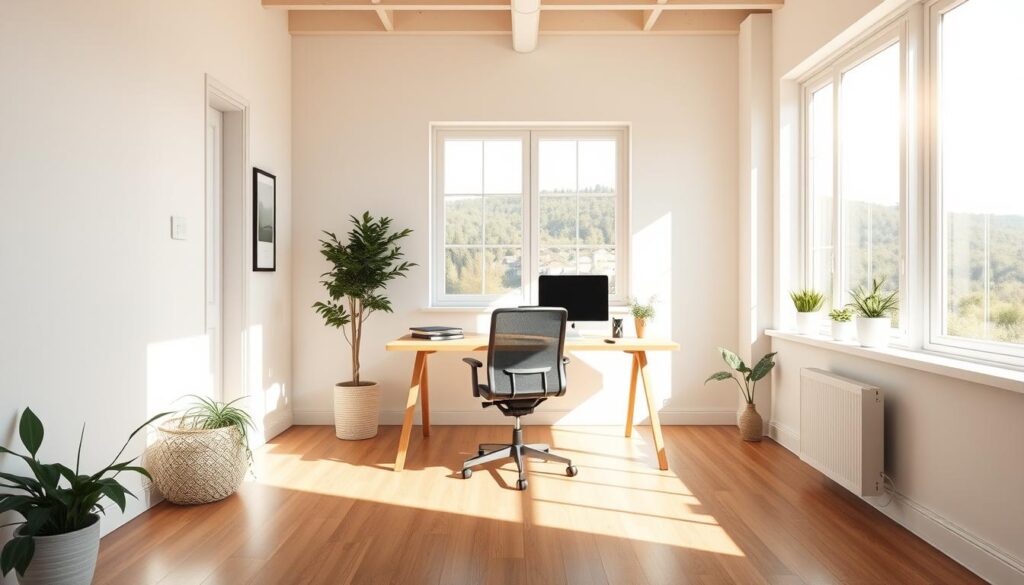
Setting up a good home office is key to being productive when working remotely. A tidy workspace keeps you focused and efficient. This helps you reach your goals.
To make your home office great, pick the best spot and choose the right furniture and technology. This way, you’ll have a space that boosts productivity and keeps your work and life balanced.
Key Takeaways
- Create a dedicated workspace to boost productivity
- Choose the ideal location for your home office
- Select the right furniture and technology for your needs
- Optimize your workspace for comfort and efficiency
- Establish a routine to maintain a healthy work-life balance
The Fundamentals of a Dedicated Workspace

Creating a productive home office is more than just setting up a desk. It’s about making a space that boosts productivity, sparks creativity, and feels comfortable.
Separating Work and Personal Life
A dedicated workspace sets a clear line between work and personal life. This is key for a healthy balance and avoiding burnout.
Here are some ways to keep work and personal life separate:
- Choose a specific area for your home office
- Stick to regular work hours
- Don’t do work stuff in your personal spaces
Creating Functional Spaces in Small Homes
You can make a functional home office, even in small homes. Here are some home office ideas:
- Use furniture that does more than one thing to save space
- Make the most of natural light to improve mood and focus
- Find a quiet spot with few distractions
By using these tips, you can set up a productive home office that fits your needs and improves your work-from-home life.
Choosing the Ideal Location for Your Home Office

The right spot for your home office can really make a difference. It affects how comfortable and efficient you are while working from home. Think about what makes a space good for work and comfort.
Considering Natural Light and Ventilation
Natural light boosts your mood and saves energy. Try to pick a spot that gets lots of sunlight. Also, having good air flow is key for a healthy workspace. It keeps air fresh and prevents breathing problems.
Minimizing Noise and Distractions
A quiet spot is vital for getting work done. Look for a place away from busy areas and outside noise. If that’s hard, use headphones or soundproofing to block out distractions.
Space Requirements for Different Professions
Every job needs different space. Graphic designers need room for big screens and drawing tools. Software developers might prefer less space but better furniture. Think about what you need for your job to find the perfect spot.
| Profession | Space Requirements | Essential Equipment |
|---|---|---|
| Graphic Designer | Large desk space, good lighting | Drawing tablet, large monitor |
| Software Developer | Ergonomic seating, multiple monitors | High-performance computer, noise-cancelling headphones |
| Writer | Quiet, comfortable seating | Reference books, comfortable keyboard |
Think about these points to make a home office that boosts your productivity and health. Whether you’re searching for work from home tips or setting up a remote work setup, picking the right location is key.
Essential Furniture for Effective Remote Work Setups
The right furniture is key to a good remote work setup. Your home office setup affects your productivity and work experience. Choosing the right furniture can greatly improve your work efficiency.
Ergonomic Desk Options
An ergonomic desk is essential for a productive home office. It helps you work comfortably and avoid injury. Look for desks that let you stand or sit, keeping you active.
Some top ergonomic desk options include:
- Standing desks that adjust to different heights
- Corner desks for maximizing space
- Desks with built-in cable management systems
Selecting the Right Office Chair
A good office chair is vital for your posture and back health. Choose a chair with good lumbar support and adjustability for your body.
Key features to look for in an office chair include:
| Feature | Description | Benefit |
|---|---|---|
| Lumbar Support | Adjustable lumbar support | Reduces back strain |
| Seat Height Adjustment | Adjustable seat height | Ensures feet are flat on floor or on a footrest |
| Armrests | Adjustable armrests | Reduces strain on shoulders and neck |
Storage Solutions for a Clutter-Free Environment
A clutter-free workspace boosts productivity. Good storage keeps your office organized, helping you focus on your work.
Here are some storage solutions for your home office:
- File cabinets for storing documents
- Shelves for books and office supplies
- Desk organizers for keeping essential items within reach
Investing in the right furniture, like ergonomic desks, comfortable chairs, and storage, makes a productive home office. It supports your remote work needs well.
Technology and Equipment Essentials
The right technology and equipment are key to a productive remote work setup. A well-configured computer, the right monitor setup, and efficient peripherals can boost your workflow.
Having the right technology is essential for remote work. Your computer is the core of your remote work setup.
Computer Setup Recommendations
Laptops are often the top choice for remote workers because they’re portable. But, if you work from one place, a desktop might be better for performance and comfort. Make sure your computer has a recent processor, enough RAM, and plenty of storage.
Monitor Configurations for Productivity
A single monitor works for simple tasks, but a dual-monitor setup boosts productivity. It lets you have several apps open at once, making your work flow better. Choose high-quality monitors that you can adjust in height and angle.
Peripherals That Enhance Workflow
Peripherals like keyboards, mice, and headphones play a big role in your productivity. Get an ergonomic keyboard and mouse to avoid injuries. Noise-cancelling headphones help you concentrate in loud places.
By focusing on these tech and equipment basics, you can make a remote work setup that’s both efficient and productive.
Optimizing Your Internet Connection
Improving your internet connection is key to a good home office. A fast and reliable internet lets you work smoothly with your team. It also helps you complete online tasks without any hiccups.
Ensuring Reliable Connectivity
To get a stable internet, think about upgrading your plan. Choose one that fits your work needs. Also, put your router in the middle of your home and keep it updated.
Backup Solutions for Internet Outages
Even with the best plans, internet can go down. Having a backup, like a mobile hotspot, helps keep you working. It’s a smart move to stay productive.
Security Considerations for Remote Work
Keeping your internet safe is just as important. Use a VPN to hide your online activity. Make sure your router’s firewall is on. Also, keep your devices and software up to date to avoid cyber threats.
| Tip | Description | Benefit |
|---|---|---|
| Upgrade Internet Plan | Increase bandwidth to support work needs | Faster data transfer and reduced lag |
| Optimize Wi-Fi Network | Place router centrally and update firmware | Improved connectivity and reduced dropped connections |
| Use VPN | Encrypt internet traffic for security | Enhanced security and privacy |
By following these tips, you can make your internet better. This ensures a productive and safe place to work from home.
Lighting Solutions for Productive Work Environments
Good lighting can make your work-from-home space more productive. A bright workspace improves your mood and cuts down eye strain. This lets you work longer without feeling tired.
Natural vs. Artificial Lighting
Natural light is great for work because it makes you feel good and helps you focus. But, not everyone has enough natural light at home. That’s when artificial lighting, like LED lights, comes in handy. They’re energy-saving and mimic natural light well.
Using both natural and artificial light is smart. Use natural light during the day and switch to artificial at night. This keeps your workspace bright all day.
Preventing Eye Strain with Proper Lighting
Eye strain is common in home offices because of bad lighting. Make sure your space is well-lit without harsh shadows or too much brightness. Adjustable desk lamps help focus light where you need it, easing eye strain.
| Lighting Type | Benefits | Best Use |
|---|---|---|
| Natural Light | Improves mood, enhances concentration | Daytime work |
| LED Lighting | Energy efficient, mimics natural daylight | Evening work or low-light conditions |
| Desk Lamps | Directs light, reduces eye strain | Task-specific lighting |
Lighting for Video Conferences
For video calls, the right lighting is key to looking good on camera. Place your computer so the light is in front of you, not behind. Softbox lights are perfect for this, as they give a soft, even light that avoids shadows.
With these lighting tips, you can make your home office a productive and comfortable space. It will support your well-being and help you succeed in your work.
Ergonomics and Health Considerations
To work well from home, focus on ergonomics and health. A good remote work setup helps avoid discomfort and health problems. This lets you work better.
Proper Posture and Positioning
Keeping the right posture is key when working from home. Make sure your chair is the right height. Your monitor should be about 20-25 inches away, right in front of you.
Your feet should be flat on the floor or on a footrest. Keep your knees at or below hip level.
Preventing Repetitive Strain Injuries
Repetitive strain injuries (RSI) are common for remote workers. To avoid RSI, take breaks, stretch, and move around. Use an ergonomic keyboard and mouse.
Adjust your workspace to support good posture.
Incorporating Movement Throughout the Workday
Moving around during the day is good for your health. Use a standing desk or a balance ball chair to stay active. Take short breaks to stretch or walk.
Try to include exercise in your daily routine.
By focusing on ergonomics and health, you can make your work from home tips more productive and comfy.
Productivity Techniques for Remote Workers
Remote work productivity comes from discipline, planning, and using the right tools. As a remote worker, you must stay focused and manage your time well to reach your goals.
Time Management Strategies
Try the Pomodoro Technique for better time management. It involves working in 25-minute focused sessions, then taking a 5-minute break. This method keeps you focused and prevents burnout.
Use the Eisenhower Matrix to sort your tasks. It separates tasks into urgent vs. important ones. By focusing on the most critical tasks first, you make the most of your time.
Digital Tools for Task Management
Many digital tools can help you manage tasks and stay organized. Trello, Asana, and Todoist let you assign tasks, set deadlines, and track progress.
“The key to productivity is not working harder, but working smarter.” – Anonymous
Using these tools can make your workflow smoother and boost your productivity.
Creating Effective Work Routines
Having a consistent work routine is key for remote workers. This means setting regular hours, having a dedicated workspace, and avoiding distractions.
Sticking to a routine helps you balance work and life. It keeps you productive all day.
Personalizing Your Home Office for Inspiration
Your home office should be more than just a place to work. It should show your style and inspire you. Adding elements that boost creativity and motivation can make your workspace better. This way, you can be more productive and follow work from home tips.
Decor Elements That Boost Creativity
Decor can change how your workspace feels. Think about adding artwork, bright colors, or unique items that inspire you. These can spark your creativity and make your office a fun place to be.
Plants and Natural Elements
Adding plants and natural elements can make your office look better and air cleaner. Plants like succulents or peace lilies are easy to care for. They bring a bit of nature to your space, fitting well with home office ideas.
Personal Touches That Motivate
Personal touches can make your office feel more welcoming and motivating. Show off your achievements, family photos, or motivational quotes. This creates a space that shows your personality and work style, following work from home tips for a productive spot.
| Personalization Element | Benefits |
|---|---|
| Artwork and Decor | Boosts creativity, adds visual interest |
| Plants and Natural Elements | Improves air quality, enhances aesthetic |
| Personal Touches | Motivates, adds personal character to the space |
By carefully personalizing your home office, you can make a space that shows your style. It also boosts your productivity and creativity, using valuable work from home tips.
Conclusion: Creating a Sustainable Remote Work Environment
Creating a sustainable remote work environment is key for staying productive and balancing work and life. By using the strategies from this article, you can make your remote work setup better.
A good home office boosts your remote work productivity. It’s not just about the right furniture and tech. It’s also about using productivity tips and keeping your workspace ergonomic.
Keep in mind, a sustainable work environment changes with your needs and supports your well-being. By choosing wisely for your workspace, you can enjoy remote work’s perks and stay productive.
FAQ
What are the key elements of a productive home office setup?
How can I minimize distractions while working from home?
What type of furniture is best for a home office?
How can I ensure reliable internet connectivity for remote work?
What are some effective productivity techniques for remote workers?
How can I personalize my home office to boost creativity and inspiration?
What are some tips for maintaining ergonomics and health while working from home?
Share :
You Might Also Like







